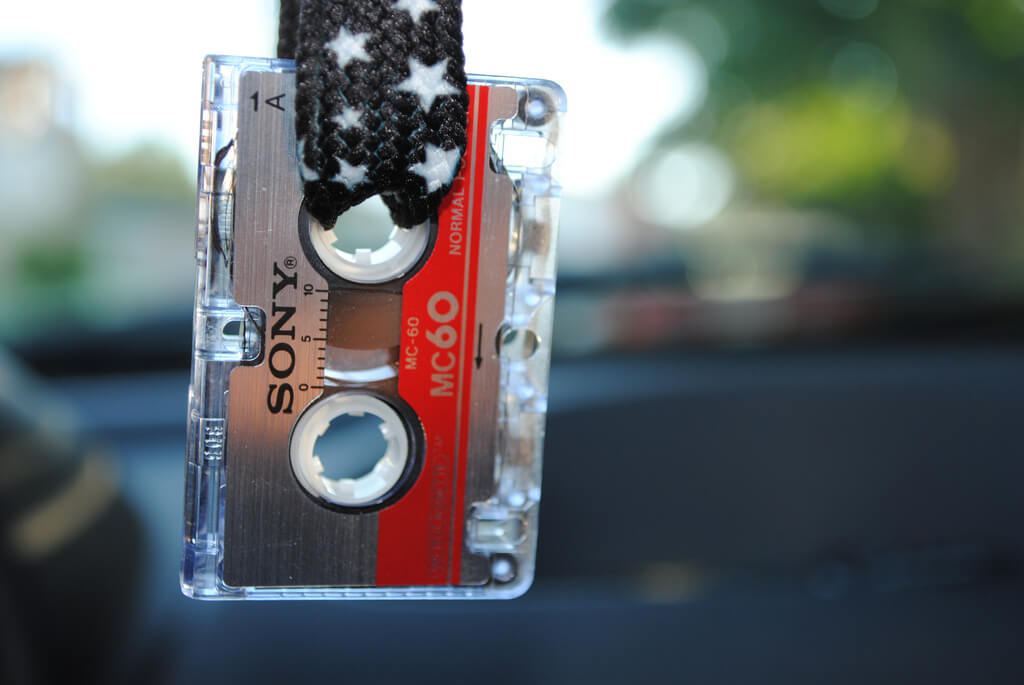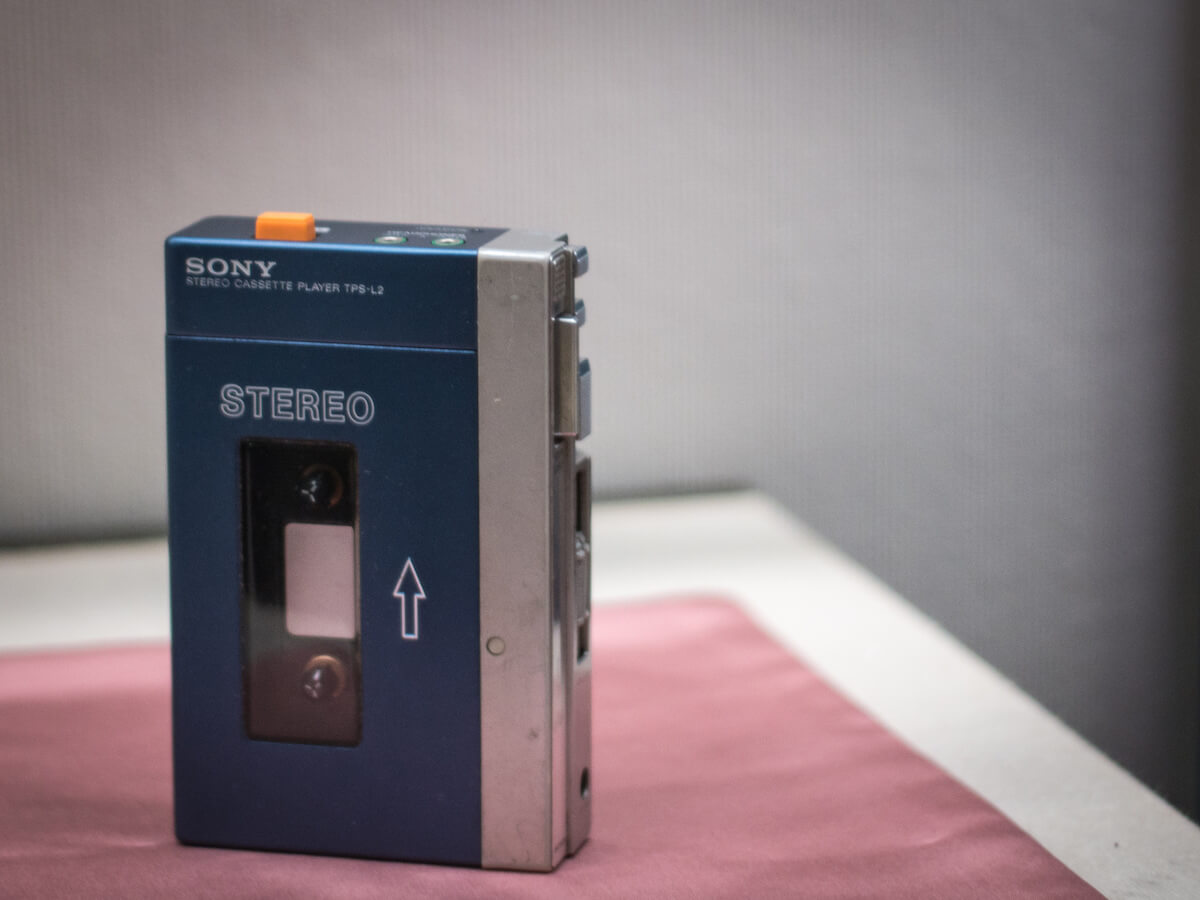In 2011, the notion of “cassette tape” was
removed from the Oxford dictionary. In this case, the tapes are alive and, moreover, quite loudly returned to the space of popular culture - and they are used not only in historical cinema, where this is justified by the situation.
Starlord in the Guardians of the Galaxy space superhero utopia rushes through the universe with an
old cassette player and a pair of mixtapes of hits from the 80s and 90s, Hannah Baker, a modern American teenager in the school drama Netflix “13 reasons why” writes stories that precede her suicide on the old tape recorder and sends a stack of cassettes in a shoe box to classmates guilty of her death.
How and why did such a seemingly outdated and devoid of technological sense format return to popular culture? Today we decided to talk about it. Sony MC-60 micro cassette / photo by Gabriel Flores Romero CC BY
Sony MC-60 micro cassette / photo by Gabriel Flores Romero CC BYIndustry: indie and lo-fi
Journalists and columnists regularly
announce a resurgence of love for audio tapes. According to Nielsen, over the past two years, cassette sales have grown by 30%, although their market share still does not exceed 0.3%.
Last year, the National Audio Company, which specializes in audio cassettes, began to build a film production plant - the last production was closed or redeveloped more than ten years ago, when the format went out of use and CD-ROMs came to replace it. In the world, today, there is a clear
shortage of cassette films - although equipment manufacturers (for example,
Sony ) still sell cassette players.
The gradual return of audio cassettes to life can be associated with diversification within the music industry — consumers' musical tastes are becoming more diverse, as are their technological and cultural interests.
So, lo-fi as a term for recording quality, there is more than half a century. Garage rock bands, The Velvet Underground and The Beatles - it would seem, now recognized classics and titans of the music industry - at the beginning of their journey also belonged to lo-fi. In the late 70s, this concept meant only poor sound quality - many groups did not have access to expensive equipment or could not record in the studio.
But lo-fi as a culture appeared relatively recently - a separate direction in music, which consciously puts a negligent attitude towards sound quality at the forefront, began to take shape in the 90s. It was a deliberate and conscious rejection of the desire to achieve flawless sound. Even if motivated by economic reasons, for example, in the era of the popularization of CDs, many people threw out huge archives of audio cassettes, which in fact became a free source of film for the money-strapped musicians. Cultural protest, challenge to the conservative society, the desire to preserve the lively and rebellious spirit of rock music - all this was laid in the noises, rattles and distortions of non-professional tape recordings.
Now there are about
450 labels in the world, which still record their music on cassettes - for them it is a way to keep in touch with analog sound. The quality, however, cassettes are inferior to the same vintage vinyl, the interest in which is also explained by the culture and (partly) fashion.
By the way, the National Audio Company is not just engaged in the popularization of the format - they
released the soundtracks for the new Star Wars and Guardians of the Galaxy on film. Remakes of classic films, TV shows and songs, as well as the widespread use of audio cassettes in modern pop culture - all these are signs of another interesting trend.
Fashion for nostalgia
In films and TV shows (from the seventies to zero), the characters use cassette tapes — many story stories revolve around cassettes of their favorite artists and mixtapes.
"A Clockwork Orange"Then the cassettes disappeared from the screens for a dozen years - and in recent years they have returned to the cultural space.
Nostalgia is an important cultural motive. It denotes ideas and images that, in spite of everything, unite certain social groups. For example, millennials may disagree with each other on some political and social issues, but they will always have common cultural ties from childhood and youth - Tetris, the soundtrack to Ghostbusters and unwinding the cassette of your favorite group to the right place with a ballpoint pen.
Nostalgia, however, exists for a reason, and it is not by chance that it is actualized in cultural production. This is primarily an appeal to the past - such as family values and age-old traditions in politics.
Secondly, the search for something new requires a lot of creative power and huge resources - film studios and TV channels can spend a lot of money and produce a movie or series, which then falls in the box office. He is not necessarily bad - just a few people like him. Niche cinema is always at risk not to pay off, so nostalgia, referring to understandable images, in this sense - a more reliable bet.
Thirdly, nostalgia became available. Previously, the process of "remembering" was socially mediated and not very simple. He depended on material objects that had to be stored - from photo albums, plates, books. In order to remember some melody from childhood, it was necessary to find the carrier on which it was recorded, the player, and get together in one place with friends to discuss what was heard.
Now, you can instantly recall anything you want - just by typing a familiar line from a song in a search engine or by throwing a link to YouTube with a video of your favorite childhood band. Nostalgia is no longer situational and does not occur “by chance” - most often we find it ourselves, because it gives us guaranteed and well-known comfort.
 Sony TPS-L2 Walkman, the interest in which was returned to the "Guardians of the Galaxy" / photo by Alexander Svensson CC BY
Sony TPS-L2 Walkman, the interest in which was returned to the "Guardians of the Galaxy" / photo by Alexander Svensson CC BYFinally, nostalgia is a construct that changes with people. Millennials grew and became a huge and solvent audience - even they
watch TV
differently . Nostalgia on the 80th and 90th, Millennial childhood appeared on the screens: the TV series “Very Strange Affairs” and “Glitter” were released,
San Junipero became the best series of the “Black Mirror”, and the “First Player to Prepare” conquered the viewer with dozens of references for movies, games and comics.
Hannah Baker writes down the history of her suicide on audio cassettes, going back to “simpler times” when a picture on Instagram couldn’t ruin life, and — causing the viewer (most likely
millennial ) to nostalgia for her own childhood, when all the most interesting and important happened around audio player.
Tool storytelling
But cultural tapes in culture are not only a way to play on nostalgia. There is another reason - they make sense from the point of view of the visual storytelling.
In today's world, everything goes into a “digital”, but the mp3 audio track is not as cinematic as the seven old audio cassettes in a shoe box or player with your favorite mixtape. What would Starlord
try to bring back if his favorite music was stored in the cloud (or, in general, on his subcortex, the technology of the Guardians of the Galaxy world of the world, this, apparently, allows)?
In digital communications, which we conduct between the cases, the element of chance is preserved - you can correct or delete the message in the messenger, improve the image in the photo editor, refine the captured video. Audio tapes are becoming an independent element of the plot - from the point of view of the depth of the story, the film has more weight than the “figure”, precisely because it is not so easy to change, rewind or put on the “rep”.
An audiotape in a film or a series is not a trend that spontaneously emerged in popular culture. Their return has a set of well-defined reasons - for example, the fashion for nostalgia and the fact that movies and TV shows are made by people who grew up in the 80s. In the end, cassettes are the latest artifact from those times when information about hundreds of years of the development of human culture was not yet available at any time from a smartphone.
What else do we write in our “Hi-Fi World”: